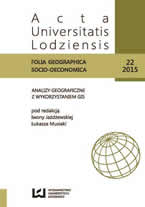Odtworzenie przebiegu linii okopów z II wojny światowej (OKH Stellung b1) w Paśmie Jałowieckim i Grupie Mędralowej na podstawie numerycznego modelu terenu z danych LiDAR i badań terenowych
Reconstruction of trenchline from Second World War (OKH Stellung b1) in Jałowiec Range and Mędralowa Mountain Group by interpretation of LiDAR data model and field research
Author(s): Paweł Franczak, Witold JuchaSubject(s): Geography, Regional studies, Regional Geography, Historical Geography, Geomatics, Maps / Cartography
Published by: Wydawnictwo Uniwersytetu Łódzkiego
Keywords: LiDAR; fortifications; trenches; The Second World War; LiDAR; Carpathians
Summary/Abstract: LiDAR (Light Detection And Ranging) data are very useful in geographical,historical and archeological studies. It is because of large ALS point cloud precision,which makes possibility of studying small forms in relief, such as unmetalled roads,historical agricultural systems, archaeological sites or old field fortifications, like trenchlines.The aim of this article is test on the usability of LiDAR data in research of trench linesbuilt during Second World War in Poland, in Beskidy Mountains. The study area chosento this text was located in Jałowiec Range and Mędralowa Mountain Group in south-westof Małopolskie voivodeship, south of Poland (Fig. 1). Jałowiec Range and MędralowaMountain Group is a continuation to the north of the Massif Babia Góra (Beskid Żywiecki,Carpathians). The fortifications were been built in this area before and during the SecondWorld War. The first objects were built by Polish Army in 1939 and second time there wasbuilt two large fortification lines 1944, by polish people forced to do it by german soldiers.The most objects in studied area were made on the slopes of Malikowski Groń. Objectsfounded in 1944 were preserved in good condition up to the present day (Tab. 1). The fewobjects have been transformed by the geomorphological processes and by overgrown treesand shrubs on them. These objects have survived to this day, because they were notdamaged during hostilities. The research was performed on a piece of trench lineon Malikowski Groń (760 ma.s.l.) about 12,2 km long (Fig. 3, Fig. 6), Lachów Groń(708 m a.s.l.) about 1,6 km long (Fig. 3) and Mędralowa Mountain Group (1169 m a.s.l)about 2,3 km long (Fig. 4). During the field test the plan of trench lines (Fig. 3C, 5B) wasperformed by using GPS mapping and by measurement of the size and depth of thetrenches. Second plan (Fig. 3B, 5A) is the result of LiDAR data analyses and vectorization.After then the obtained results were compared in research analysis. The trenchlines and objects are quite good visible in LiDAR data, but it is impossible to do theclassification of point objects made in field observation (Tab. 1, 2, 3). However, asa general comment, it is the possibility to signing the object classes in neighbor areas byway of analogy to field testing research.
Journal: Acta Universitatis Lodziensis. Folia Geographica Socio-Oeconomica
- Issue Year: 22/2015
- Issue No: 4
- Page Range: 87-108
- Page Count: 22
- Language: Polish

